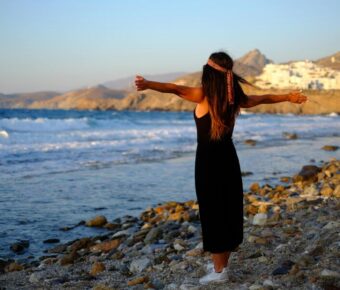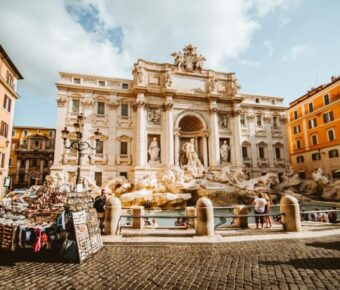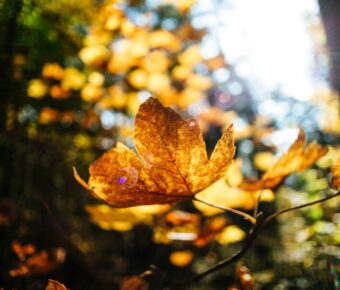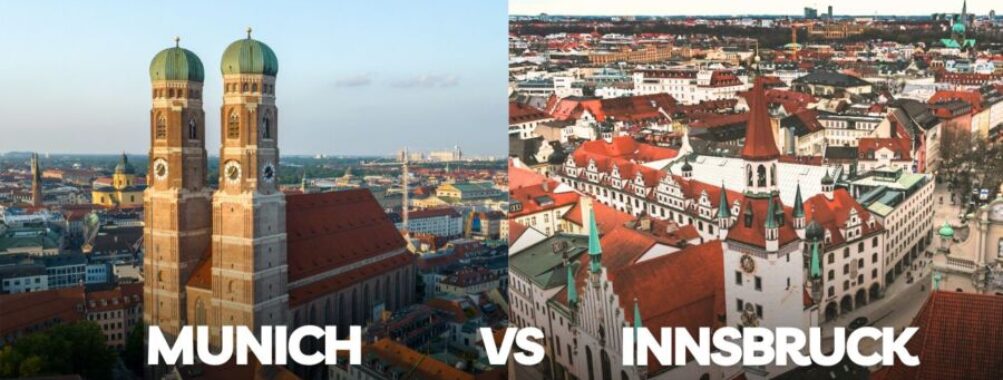
Munich vs Innsbruck: 5 Key Differences to Know Before Your Alpine Adventure
Choosing between Munich and Innsbruck often depends on what kind of travel experience you seek. Munich offers the vibrant energy of a major German city with world-class museums, shopping, and that famous Bavarian beer culture. Innsbruck, nestled in the Austrian Alps, provides a more intimate mountain town feel with stunning alpine views from the city center.
While Munich excels at urban attractions and nightlife, Innsbruck shines when it comes to easy access to outdoor activities like skiing and mountain hiking. The smaller Austrian city feels more quaint and manageable, perfect for travelers who want nature at their doorstep without sacrificing cultural experiences.
If you can’t decide between city life and mountain charm, Munich makes a convenient base with day trips possible to alpine areas. But for those who prioritize waking up to mountain views and prefer a less touristy atmosphere, Innsbruck creates a more authentic Alpine experience that captures the essence of Tyrol.
Contents
- Overview of Munich
- Cultural Significance
- Munich Hauptbahnhof and Public Transport
- Famous Attractions in Munich
- Overview of Innsbruck
- Historical Background
- Innsbruck Transportation Hub
- Key Tourist Spots in Innsbruck
- Culinary Experiences
- Dining in Munich
- Local Cuisine of Innsbruck
- Augustiner Breweries
- Cultural Events and Festivals
- Oktoberfest in Munich
- Innsbruck’s Seasonal Celebrations
- Museum and Art Scene
- Munich’s Museums
- Innsbruck’s Art Galleries
- Outdoor and Recreational Activities
- Green Spaces in Munich
- Natural Attractions in Innsbruck
- Shopping and Commerce
- Munich’s Markets and Boutiques
- Innsbruck’s Shopping Experience
- Comparing Munich and Innsbruck
- Cost of Travel
- Accessibility and Transportation
- Unique Experiences in Each City
- Frequently Asked Questions
- What unique attractions can Munich offer compared to Innsbruck?
- How do the cultural experiences differ between Munich and Innsbruck?
- What are the travel times and transportation options for visiting the Bavarian Alps from Innsbruck and Munich?
- Can Munich serve as a convenient hub for exploring the surrounding regions?
- In terms of local cuisine, how does Munich’s gastronomy differ from Innsbruck?
- What are the hidden gems or lesser-known activities in Innsbruck for travelers who have already seen the main sights?
- More Travel Guides
Overview of Munich
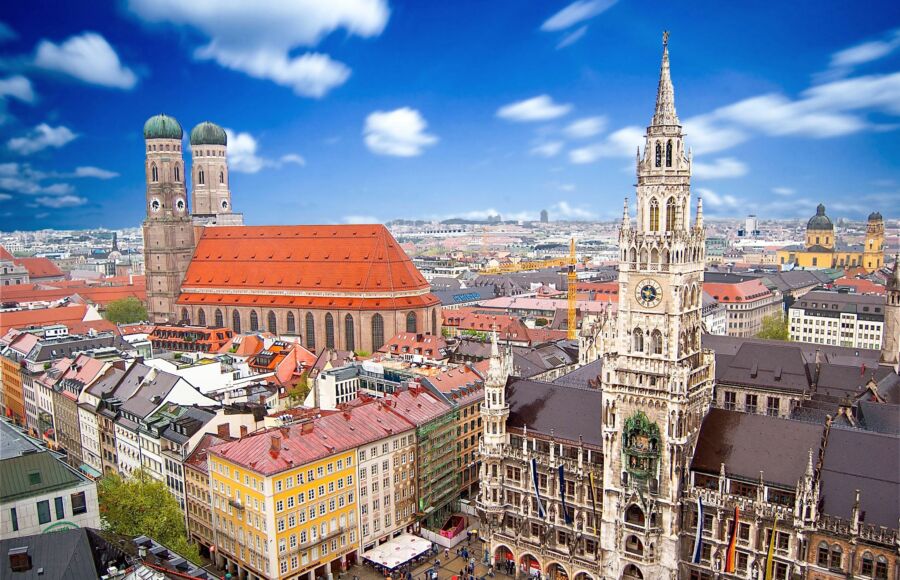
Munich, the capital of Bavaria, is a vibrant German city that blends traditional culture with modern urban life. It offers visitors impressive architecture, world-class museums, beautiful parks, and a distinctive local atmosphere that sets it apart from other European destinations.
Cultural Significance
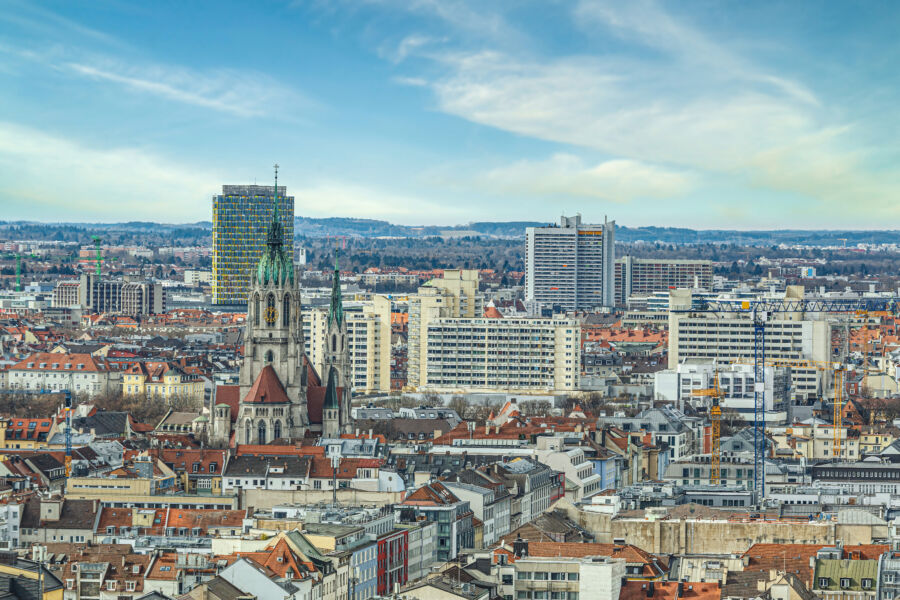
Munich is Bavaria’s cultural heart, with a rich history dating back to 1158. The city successfully balances its traditional Bavarian heritage with a cosmopolitan outlook. You’ll notice this blend everywhere—from locals wearing lederhosen during Oktoberfest to cutting-edge art in modern galleries.
Munich’s beer culture is legendary. The city’s famous beer halls, like Hofbräuhaus, date back centuries and remain central to local life. The annual Oktoberfest attracts over 6 million visitors from around the world.
The arts thrive here, too. Munich boasts over 80 museums, including the renowned Alte Pinakothek, which houses masterpieces by Dürer, Raphael, and Rembrandt. The Bavarian State Opera presents world-class performances year-round.
Munich Hauptbahnhof and Public Transport

Munich’s transportation system is impressively efficient and easy to navigate. The Hauptbahnhof (main train station) is the city’s transit hub, connecting local, regional, and international rail services. The striking building dates from 1839 but has been modernized several times.
The public transport network includes:
- U-Bahn (subway): 8 lines covering most major attractions
- S-Bahn (suburban trains): 8 lines connecting downtown to suburbs and the airport
- Trams: 13 lines offering scenic above-ground routes
- Buses: Extensive network filling gaps between rail services
A single ticket works across all transport types in the MVV network. The Munich CityTourCard offers unlimited travel plus discounts at many attractions. Most city center highlights are within walking distance of stations.
Famous Attractions in Munich

Marienplatz forms the vibrant heart of Munich’s historic center. This medieval square features the Neo-Gothic New Town Hall with its famous Glockenspiel clock that performs daily at 11 a.m. and noon. The Old Town Hall and Mariensäule (Mary’s Column) also grace this bustling plaza.
The English Garden ranks among the world’s largest urban parks, spanning 910 acres. It’s even bigger than New York’s Central Park! Visitors can watch surfers riding the standing wave on Eisbach Creek, relax in beer gardens, or stroll through beautiful meadows and wooded areas.
Other must-see attractions include Nymphenburg Palace, the former royal residence with magnificent gardens. The BMW Museum showcases the iconic German automaker’s history. The Olympic Park, built for the 1972 Games, offers panoramic city views from its observation tower.
Overview of Innsbruck

Innsbruck is a charming Austrian city nestled in the heart of the Alps. This mountain-ringed destination offers visitors a unique blend of historical architecture, outdoor adventures, and cultural experiences, all while serving as an excellent transportation hub for exploring the surrounding Alpine region.
Historical Background

Innsbruck’s story began in the 12th century when it was established as a market town. The city’s golden age arrived in the 15th century when Emperor Maximilian I chose it as his imperial residence. This royal connection shaped much of what you see today.
The Habsburg dynasty left its mark on the cityscape. The famous Golden Roof (Goldenes Dachl), built in 1500, is the most iconic symbol of Innsbruck’s imperial past. Made with 2,657 copper tiles, it was a royal box where the emperor could watch festivals in the square below.
Innsbruck hosted the Winter Olympics twice (1964 and 1976) during the 20th century, modernizing the city and cementing its reputation as a winter sports paradise. Today, this blend of medieval charm and alpine setting attracts visitors year-round.
Innsbruck Transportation Hub

Innsbruck serves as the perfect base for exploring the Alps region. The city’s main train station connects directly to major cities like Munich (about 2 hours away) and Salzburg, making day trips convenient.
The city’s public transportation system is efficient and tourist-friendly. Buses and trams cover all major attractions, and many hotels offer free passes to guests.
For mountain access, several cable cars operate right from the city center. The Nordkette Cable Car takes you from downtown to high alpine terrain in just 20 minutes – a rare urban-to-wilderness connection few cities can match.
Innsbruck Airport offers connections to European destinations, though most international travelers arrive via Munich or Vienna. This central location between Germany, Italy, and other parts of Austria makes Innsbruck perfect for multi-country Alpine itineraries.
Key Tourist Spots in Innsbruck
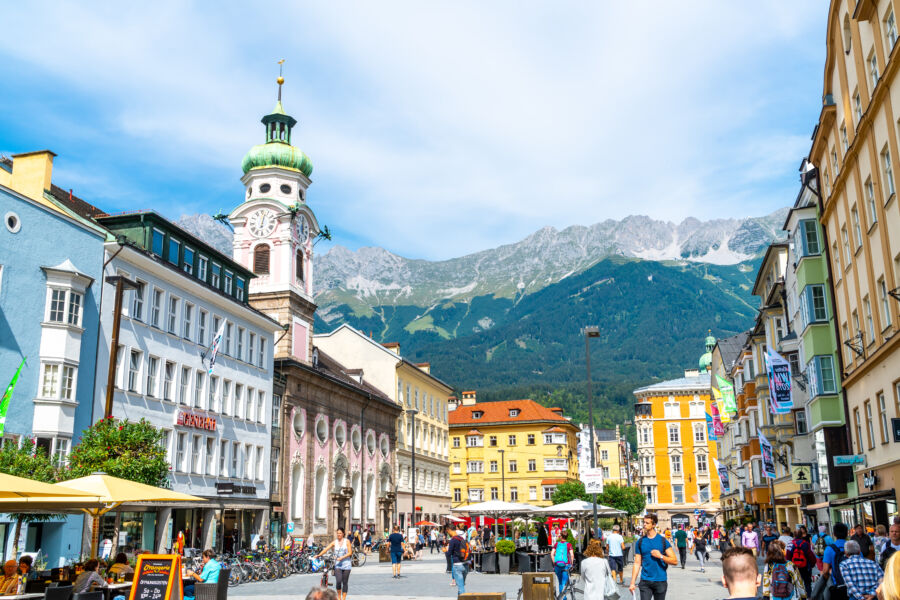
The Old Town (Altstadt) captivates visitors with its colorful medieval buildings and narrow streets. Besides the Golden Roof, don’t miss the Imperial Palace (Hofburg) and Court Church’s incredible bronze statues.
Take the Nordkette Cable Car to the “Top of Innsbruck” at 7,400 feet for panoramic views. The journey itself is worth it, designed by star architect Zaha Hadid.
Another Hadid creation, the Bergisel Ski Jump, offers sporting history and spectacular city views. In winter, it hosts competitions; in summer, it serves as a unique viewing platform.
Museum lovers should visit the Tyrolean Folk Art Museum and Swarovski Crystal Worlds just outside the city. The latter features dazzling crystal installations in underground chambers.
To taste local culture, explore the bustling Maria-Theresien-Strasse, the main shopping boulevard with cafés serving traditional Tyrolean specialties like Käsespätzle (cheese noodles) and Strudel.
See Related: Munich vs Salzburg: Stunning Differences Between These Alpine Gems
Culinary Experiences

Munich and Innsbruck offer distinctive food scenes showcasing their regional specialties and cultural heritage. Food lovers will find unique flavors, brewing traditions, and dining atmospheres that reflect the character of each city.
Dining in Munich
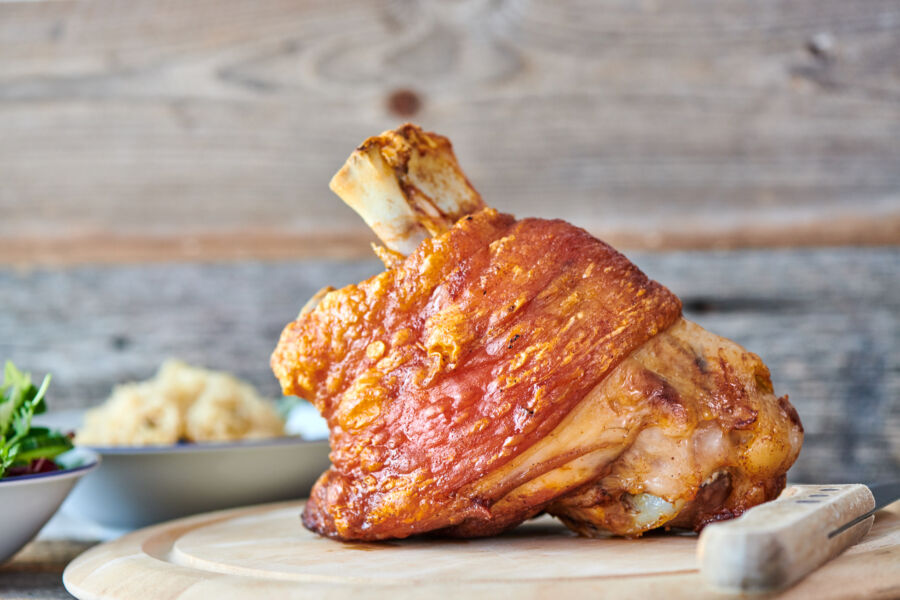
Munich’s food scene blends traditional Bavarian cooking with modern culinary trends. The city boasts over 5,000 restaurants, from casual beer halls to upscale dining establishments.
Typical Bavarian dishes dominate menus across Munich. You’ll find plenty of pork knuckles (Schweinshaxe), weisswurst (white sausage), and pretzels (Brezel) served with sweet mustard. These hearty dishes pair perfectly with the city’s famous beer.
The Viktualienmarkt, Munich’s daily food market, offers a fantastic place to sample local specialties. Vendors sell everything from fresh produce to gourmet cheese and exotic spices. It’s a great spot to grab a quick lunch or shop for picnic supplies.
Many restaurants in Munich feature seasonal menus that highlight fresh, local ingredients. Fall brings game dishes and mushroom specialties, while summer menus feature lighter fare with fresh vegetables.
Local Cuisine of Innsbruck

As the capital of Austria’s Tirol Province, Innsbruck showcases Alpine cuisine influenced by Austrian and Italian cooking traditions. The city is known for quality local ingredients and authentic recipes passed down through generations.
Typical Tirolean dishes include Käsespätzle (cheese noodles), Tiroler Gröstl (a hearty pan of potatoes, meat, and onions), and Knödel (dumplings) in various forms. These dishes reflect the region’s mountain culture.
Innsbruck Food Tours allows visitors to explore the city’s culinary landscape. These immersive experiences connect travelers with local flavors and the stories behind them. It’s a unique way to discover hidden gems and learn about Innsbruck’s food traditions.
The city’s cafés serve exceptional pastries and cakes. Try Sachertorte (chocolate cake) or Apfelstrudel (apple strudel) with a strong Austrian coffee.
Augustiner Breweries

The Augustiner brewing tradition spans both cities, though each location offers distinctive experiences. These historic breweries offer more than just beer—they glimpse the region’s brewing heritage.
In Munich, Augustiner is the oldest independent brewery, dating back to 1328. Its beer garden (Augustiner-Keller) ranks among the city’s best, serving traditional Bavarian food alongside its famous beer. The brewery still uses wooden barrels for some of its beers, maintaining centuries-old traditions.
Salzburg (near Innsbruck) features the impressive Augustiner Bräu, a must-visit establishment where monks originally brewed the beer. The large beer garden and indoor beer hall create a lively atmosphere that attracts locals and tourists.
The brewing process at Augustiner follows strict purity laws. They use only water, malt, hops, and yeast—no additives or preservatives. This commitment to quality makes their beers special and distinctive from mass-produced varieties.
Cultural Events and Festivals

Munich and Innsbruck host vibrant cultural events throughout the year that showcase their unique traditions and local flavor. These festivals offer travelers an authentic glimpse into the local culture and often become the highlight of any visit.
Oktoberfest in Munich
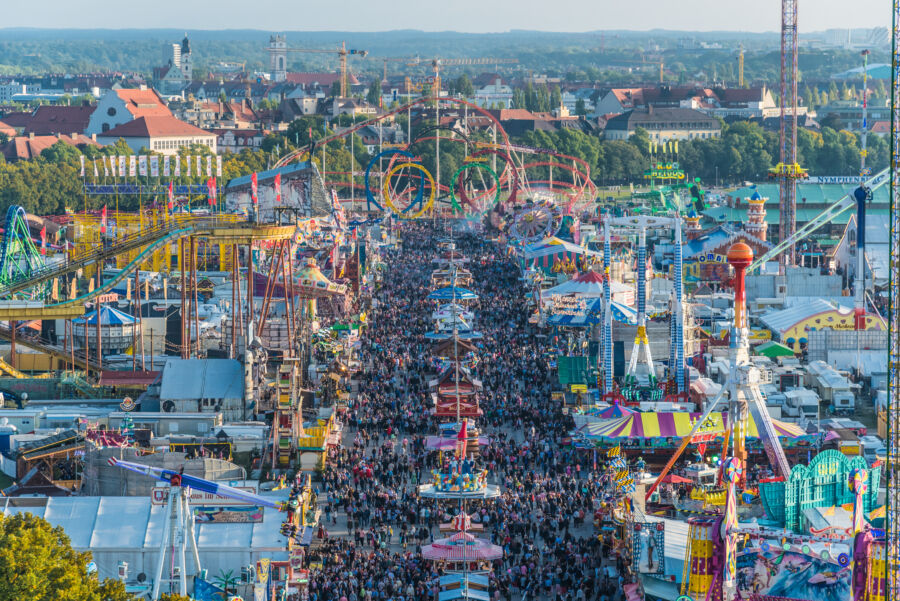
Oktoberfest is Munich’s crown jewel of festivals and the world’s largest folk festival. Every year, over six million visitors flood the city from mid-September to early October to experience this 16-day celebration. The festival grounds (Theresienwiese) transform into a bustling wonderland of massive beer tents, carnival rides, and traditional Bavarian music.
You’ll see locals and tourists dressed in dirndls and lederhosen, raising their one-liter beer steins while singing German folk songs. The atmosphere is electric! Each tent has its personality – some more traditional, others more rowdy.
Beyond the beer, Oktoberfest offers delicious Bavarian food like pretzels, sausages, and roast chicken. A parade with horse-drawn beer wagons and people in historical costumes showcasing Bavarian history and culture.
Innsbruck’s Seasonal Celebrations

Innsbruck shines with its more intimate but equally charming festivals throughout the year. The Christmas markets transform the Old Town into a magical wonderland in winter. Stalls sell handcrafted ornaments, mulled wine, and local treats against snow-capped mountains.
The Innsbruck region also hosts impressive summer events featuring international music acts, dance performances, and visual arts. These cultural gatherings blend traditional Alpine culture with contemporary elements.
Fasching (carnival season) is another highlight, with colorful parades and costume parties filling the streets. The Tyrolean Folk Art Festival showcases local traditions with performers in traditional dress demonstrating ancient customs and crafts.
Bergisel Ski Jump Tournament draws sports enthusiasts every January as part of the prestigious Four Hills Tournament, combining athletic competition with festive celebration in true Tyrolean style.
Museum and Art Scene
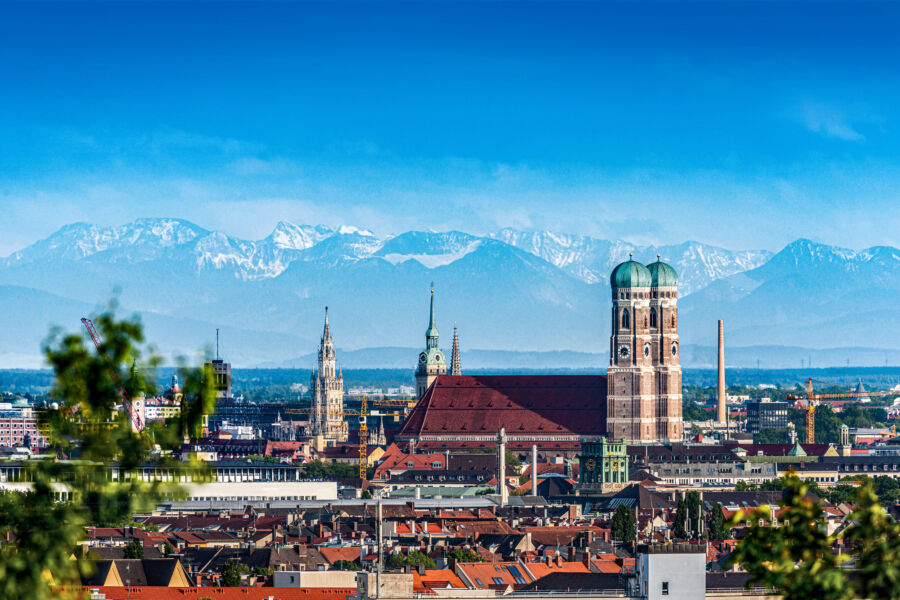
Both cities offer rich cultural experiences through their museums and art galleries. Munich boasts world-class art collections spanning centuries, while Innsbruck presents a more intimate but fascinating art scene with historical significance.
Munich’s Museums

Truly impressive. The city is home to an incredible collection of museums that would make any art lover swoon. The Kunstareal (art district) houses several world-class institutions, all within walking distance of each other.
The Alte Pinakothek is a must-visit for fans of classical art. It contains masterpieces from the 14th to 18th centuries, including works by Dürer, Rembrandt, and da Vinci. Not far away, the Neue Pinakothek focuses on 19th-century art.
For modern art enthusiasts, Lenbachhaus is a real treat. It houses the world’s most comprehensive collection of “Blue Rider” (Blauer Reiter) works – an influential expressionist movement. The building itself is a beautiful blend of historic and contemporary architecture.
Munich also offers specialized museums for science and technology buffs, like the BMW Museum and Deutsches Museum. Most museums offer English audio guides and are easily accessible by public transport.
Innsbruck’s Art Galleries

Innsbruck may be smaller than Munich, but its art scene is charming and distinctive. The city’s artistic offerings reflect its alpine heritage and long history as a cultural crossroads in the Tyrol region.
The Tyrolean State Museum (Tiroler Landesmuseum Ferdinandeum) is the highlight, housing an impressive collection of Gothic art and artifacts. The collection spans from prehistoric times to the present, with particular strength in regional artwork.
Innsbruck’s art scene feels more intimate and manageable than Munich’s vast collections. Most major galleries can be explored in a single day, making it perfect for travelers with limited time.
The city’s art spaces are often housed in historic buildings, adding architectural interest to your visit. The Imperial Palace (Hofburg) features beautiful ceiling frescoes and offers a glimpse into royal artistic patronage.
Many smaller galleries showcase contemporary Alpine artists, providing insight into modern Tyrolean culture. These spaces often feel less crowded than Munich’s famous museums.
Outdoor and Recreational Activities
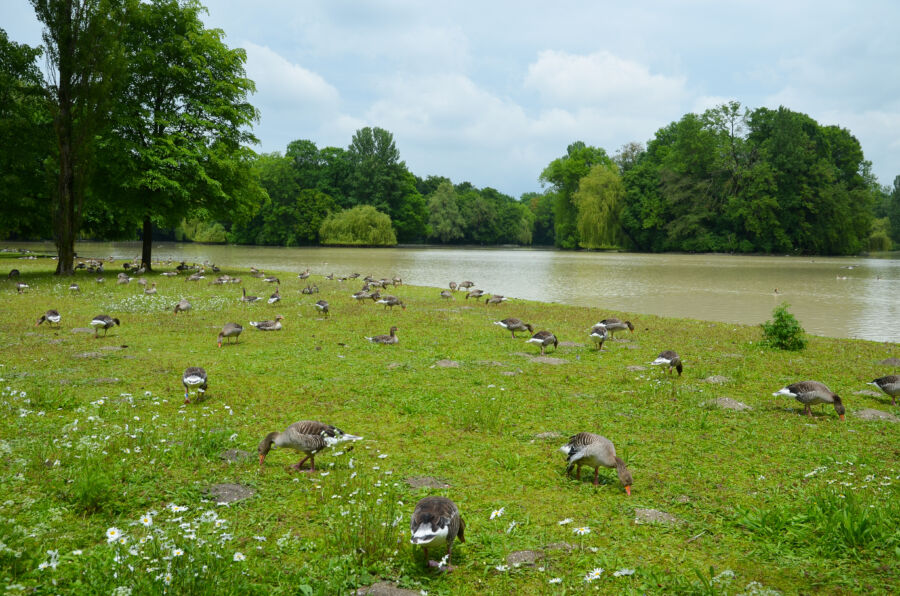
Munich and Innsbruck offer stunning outdoor experiences catering to nature lovers and adventure seekers. While Munich boasts expansive urban parks, Innsbruck’s mountainous terrain provides exceptional hiking and winter sports opportunities.
Green Spaces in Munich
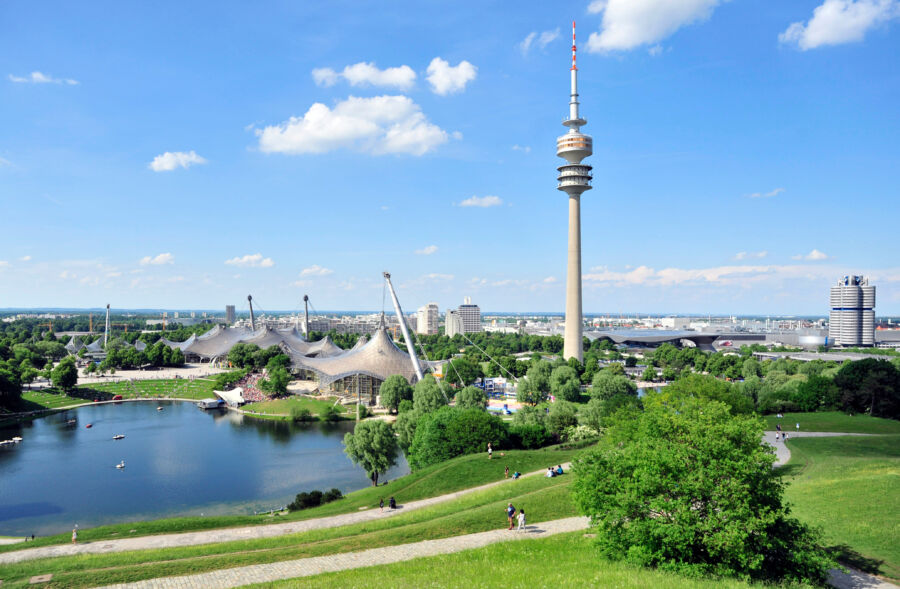
Munich’s crown jewel is the English Garden (Englischer Garten), one of the world’s largest urban parks. Spanning over 900 acres, it’s even bigger than New York’s Central Park! Locals and tourists enjoy sunbathing, picnicking, and people-watching along its winding paths and open meadows.
The garden features a Japanese teahouse, several beer gardens, including the famous Chinese Tower (Chinesischer Turm), and the Eisbach wave, where brave surfers ride year-round. Seeing people surfing in the middle of a city is quite a sight!
Other notable green spaces include Olympiapark, which was built for the 1972 Olympics. Visitors can climb the Olympic Tower for panoramic views or boat on the lake below.
For families, the Westpark offers playgrounds, gardens, and open spaces perfect for kicking a ball around or relaxing after sightseeing.
Natural Attractions in Innsbruck

Innsbruck’s stunning location in the heart of the Alps makes it an outdoor enthusiast’s paradise. The city is surrounded by majestic mountain ranges that provide a breathtaking backdrop and plenty of recreational opportunities.
The Nordkette mountain range is accessible directly from the city center via a funicular railway and cable car system. In just 20 minutes, travelers can go from downtown to high alpine terrain at over 2,000 meters. The views of the Inn Valley are spectacular!
Hiking trails abound for all skill levels. Easy walks like the Zirbenweg (Stone Pine Path) offer gentle terrain with amazing views, while more challenging routes lead to alpine peaks and mountain huts.
Winter transforms Innsbruck into a sports wonderland with world-class skiing and snowboarding facilities. The Olympic ski jump at Bergisel is open year-round and provides history and stunning views of the city below.
Mountain biking, paragliding, and rock climbing options exist for thrill-seekers, while gentler activities like riverside walks along the Inn provide peaceful alternatives.
See Related: New Train Routes in Europe to Explore
Shopping and Commerce

Munich and Innsbruck offer distinct shopping experiences that reflect their unique character and culture. Munich stands out as a major commercial hub with extensive options, while Innsbruck provides a more intimate shopping atmosphere with its special charm.
Munich’s Markets and Boutiques

Munich is a shopper’s paradise with something for every budget and taste. The city center features the famous Kaufingerstrasse and Neuhauser Strasse, two pedestrian zones packed with international chains and local boutiques.
Marienplatz, the heart of Munich, is surrounded by department stores like Galeria Kaufhof and the upscale Fünf Höfe shopping arcade. For luxury shoppers, Maximilianstrasse offers high-end designer brands like Louis Vuitton and Gucci.
The city truly shines with its markets. Viktualienmarkt, a daily food market, sells fresh produce, flowers, and Bavarian specialties. The Christkindlmarkt transforms Marienplatz into a magical shopping experience with handcrafted gifts and ornaments during Christmas.
Munich’s shopping scene extends to its suburbs, with massive malls like Olympia Einkaufszentrum providing everything under one roof.
Innsbruck’s Shopping Experience

Innsbruck offers a more compact but charming shopping scene compared to Munich. The Maria-Theresien-Strasse, the main shopping street, has historic buildings housing boutiques, cafés, and specialty stores.
The Altstadt (Old Town) features unique shops selling Tyrolean crafts, traditional clothing, and local products. Visitors can find authentic souvenirs, such as handcrafted wooden items, lederhosen, dirndls, and Alpine jewelry, reflecting the region’s rich heritage.
Rathausgalerien, a modern shopping center near the Golden Roof, provides a mix of international and Austrian brands. The Kaufhaus Tyrol department store offers high-quality goods in a contemporary setting for those seeking luxury items.
What makes Innsbruck’s shopping special is its focus on quality over quantity. The city prides itself on artisanal products and local craftsmanship rather than mass-market goods. Shops like the Swarovski flagship store showcase products with strong local ties.
Shopping in Innsbruck feels more personal and less overwhelming than in Munich, making it ideal for travelers who prefer a relaxed pace.
Comparing Munich and Innsbruck
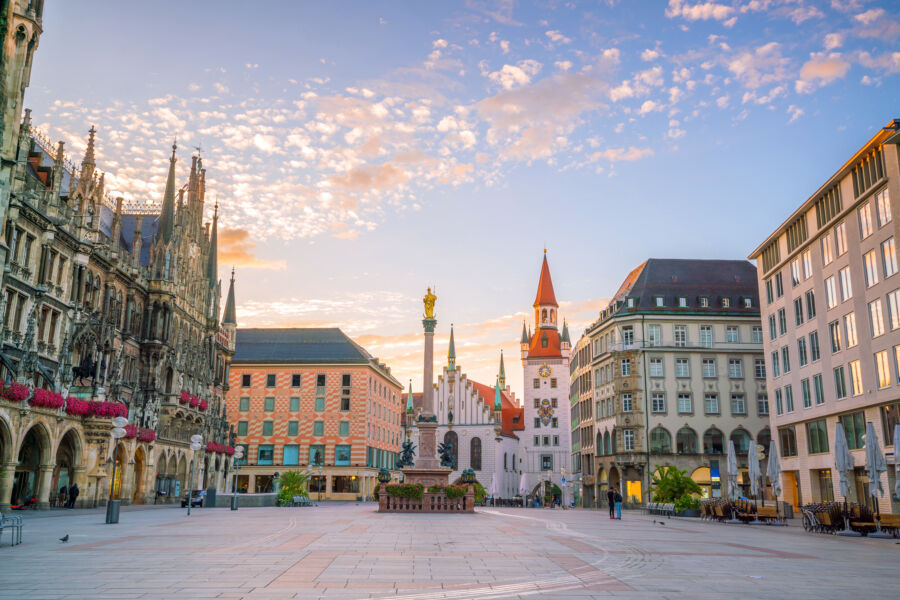
Munich and Innsbruck offer distinct travel experiences despite their relative proximity. Both cities showcase unique cultural elements, different cost structures, and varied transportation options that can significantly impact your travel plans.
Cost of Travel

Munich tends to be more expensive overall than Innsbruck. According to cost of living comparisons, you would need about €6,041 in Munich to maintain the lifestyle that €5,500 would get in Innsbruck. This difference of roughly 10% applies when considering accommodation costs.
Day-to-day expenses like dining out and local transportation also reflect this price gap. Munich’s popularity as a major European destination drives up prices, especially during peak events like Oktoberfest when accommodation costs triple.
Innsbruck, being a smaller tourism-focused city, offers better value in terms of:
- Accommodation options
- Local eateries
- Attraction entry fees
However, the mountain activities around Innsbruck (like skiing) can be pricey during winter.
Accessibility and Transportation
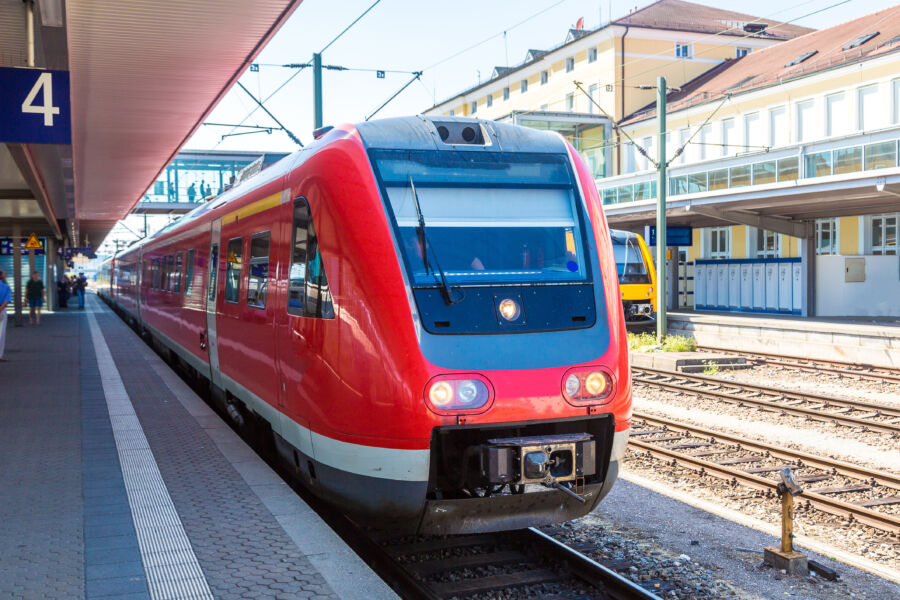
Munich boasts excellent transportation infrastructure centered around Munich Hauptbahnhof, one of Germany’s busiest railway stations. The city serves as a major transportation hub with:
- Direct trains to major European cities
- An efficient U-Bahn and S-Bahn network
- Munich Airport offers connections worldwide
Innsbruck, while smaller, is remarkably well-connected for its size. The city’s position along key Alpine routes makes it accessible by:
- Regular rail service from Munich (about 2 hours)
- Scenic mountain routes
- Regional connections to Italy and Switzerland
The route between Munich and Innsbruck offers stunning Alpine views. Travelers can enjoy minimal road riding when taking the scenic path through Jenbach, Achensee, and Tegernsee.
Unique Experiences in Each City
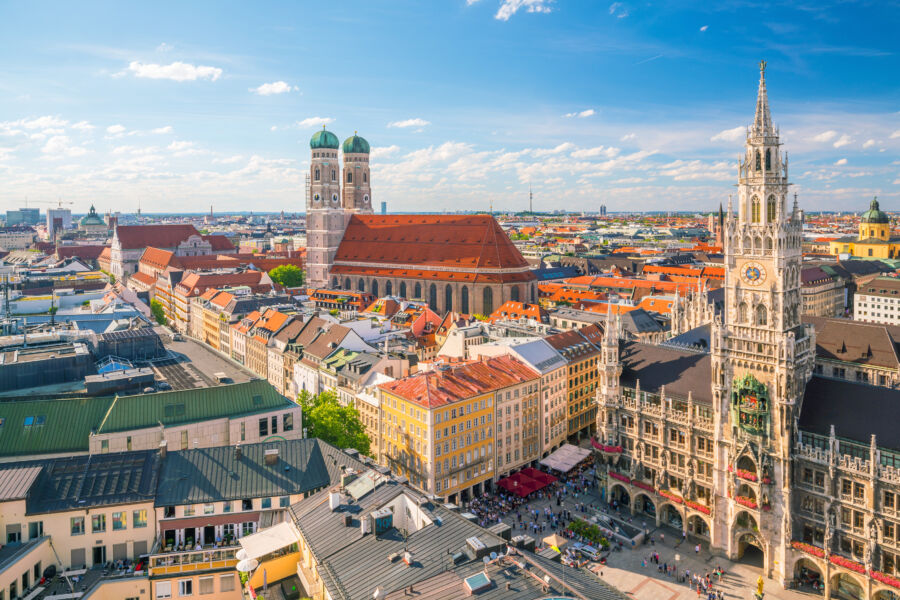
Munich delivers a world-class urban experience with renowned museums, a sprawling English Garden, and a vibrant Marienplatz. The city’s beer halls, like the famous Hofbräuhaus, provide authentic Bavarian culture year-round, not just during Oktoberfest.
Visitors often praise Munich for its impressive scale and variety of attractions. The city seamlessly blends historical architecture with modern amenities.
Innsbruck offers a charming, quaint experience centered around its colorful medieval old town with the famous Golden Roof. Being surrounded by mountains makes it perfect for:
- Alpine Adventures is within minutes of downtown
- Winter sports at nearby resorts
- Stunning panoramic views from the Nordkette cable car
The river running through Innsbruck adds to its picturesque quality. It’s ideal for travelers seeking a more intimate Alpine experience with easy access to outdoor activities.
See Related: Exploring Germany in 7 Days: An Itinerary of Castles, Culture, and Cuisine
Frequently Asked Questions

Munich and Innsbruck offer distinct travel experiences despite their proximity. Travelers often compare these cities when planning Alpine adventures, with each destination having unique appeal and practical considerations.
What unique attractions can Munich offer compared to Innsbruck?
Munich boasts several world-class attractions you won’t find in Innsbruck. The Deutsches Museum is one of the world’s largest science and technology museums, featuring interactive exhibits that appeal to curious minds of all ages.
The English Garden in Munich is larger than New York’s Central Park, offering vast green spaces for relaxation, people-watching, and even surfing on the artificial wave in the Eisbach creek.
BMW Welt and Museum showcases Germany’s automotive excellence with sleek displays of historic and futuristic vehicles. This attraction draws car enthusiasts from around the world.
How do the cultural experiences differ between Munich and Innsbruck?
Munich offers a more cosmopolitan cultural scene with numerous world-class museums like the Alte Pinakothek and Neue Pinakothek, housing European masterpieces spanning centuries.
Innsbruck provides a more intimate Alpine cultural experience, with its Golden Roof and Imperial Palace reflecting Tyrolean heritage. The city’s manageable size makes cultural exploration feel more accessible and personal.
Munich’s Bavarian traditions come alive during festivals like Oktoberfest, while Innsbruck showcases authentic Tyrolean folk music and dance performances throughout the year. Both celebrate their heritage but with different regional flavors.
What are the travel times and transportation options for visiting the Bavarian Alps from Innsbruck and Munich?
From Innsbruck, you can reach stunning Alpine scenery within minutes via the Nordkette cable car. This provides almost immediate access to high-mountain terrain directly from the city center.
Munich requires longer travel times to reach the Alps, typically 1-2 hours by car or train. Popular destinations like Garmisch-Partenkirchen take about 1.5 hours from Munich.
Both cities offer excellent public transportation options. Regional trains connect Munich to Alpine destinations, while Innsbruck’s position nestled within the mountains gives it a natural advantage for quick mountain access.
Can Munich serve as a convenient hub for exploring the surrounding regions?
Munich functions exceptionally well as a travel hub with excellent rail connections. Direct trains run frequently to Salzburg, Innsbruck, and numerous Bavarian towns, making day trips convenient.
The city’s international airport offers more connections than Innsbruck, making combining a Munich stay with visits to other European destinations easier.
Munich’s comprehensive public transportation system extends well into the surrounding countryside via the Bayern-Ticket, which provides all-day regional travel for an affordable price of €26-49 depending on group size.
In terms of local cuisine, how does Munich’s gastronomy differ from Innsbruck?
In its beer halls and traditional restaurants, Munich showcases classic Bavarian dishes like weisswurst (white sausage), pretzels, and leberkäse. The city’s beer culture is world-renowned, with six major breweries producing distinctive local styles.
Innsbruck’s cuisine features Tyrolean specialties like speckknödel (bacon dumplings), käsespätzle (cheese noodles), and gröstl (a hearty pan-fried dish with potatoes and meat). Alpine influences are more pronounced here.
Both cities serve hearty, satisfying food, but Innsbruck’s cuisine tends to incorporate more Alpine herbs and mountain ingredients, while Munich’s food scene is more diverse with excellent international options.
The Audioversum Science Center offers an interactive journey through the world of sound and hearing. Families and those seeking unique educational experiences away from the typical tourist path will find it perfect.
Ambras Castle, slightly outside the city center, houses an impressive collection of armor and artwork in a Renaissance palace with beautiful gardens. Many visitors miss this attraction despite its historical significance.
The Botanical Gardens of Innsbruck University showcase Alpine flora and exotic plants in a peaceful setting. Nature lovers seeking a quiet retreat from the busier attractions will find it an ideal spot.
